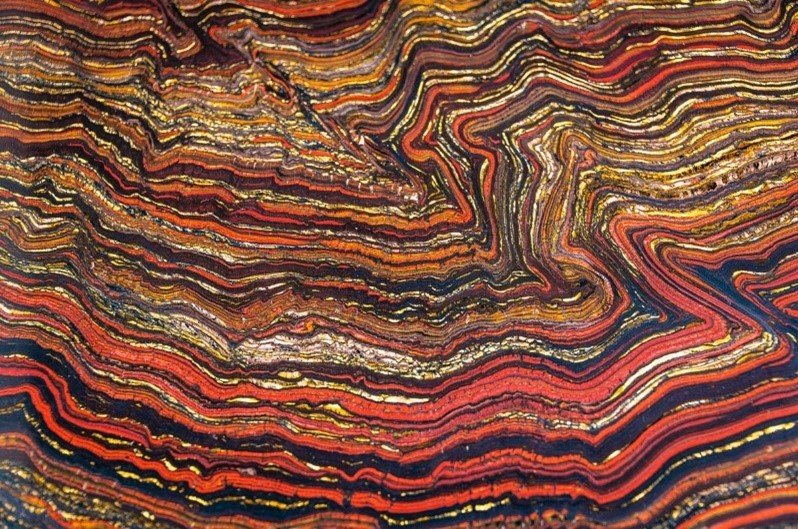Key points
- Australia is the world's largest iron ore exporter.
- Banded iron formations (BIFs) make up a lot of Australia's iron ore reserves.
- Iron ore is used to make steel, an energy-intensive process we are working on to significantly reduce emissions.
Iron ore is a big deal in Australia.
We are the world’s largest iron ore exporter. Iron ore brings in $133 billion annually (2021-2022) and provides 43,000 Australians mining jobs. Iron ore is rock rich in iron oxides (Fe2O3) and includes minerals like hematite and magnetite.
Most of the world’s iron ore is found in rocks called banded iron formations or BIF. BIF occur on all continents, and in all states of Australia. Western Australia accounts for 90 per cent of our iron ore. What many people don’t realise is this rich mineral endowment is due to hardworking tiny photosynthetic bacteria many millennia ago.
BIF are like ancient storytellers etched in stone. Although they’re on land now, their story starts in the ancient oceans.

Ancient oceans and algae
BIF are sedimentary rocks with alternating layers of iron rich material and silica, forming bands of light and dark.
Many BIF around the world were formed between 3.5 billion and 1.8 billion years ago. These ancient oceans had high levels of dissolved silica and iron, being washed into the oceans off the land. Then tiny bacteria, called cyanobacteria, developed photosynthesis, forming colonies known as stromatolites. Stromatolites can still be seen today in Shark Bay and Lake Clifton in Western Australia.
Oxygen enters the ancient oceans
As the bacteria began photosynthesising, they also began started releasing oxygen into the oceans. Seasonal blooms of algae boosted the amount of oxygen in the seawater. Oxygen then reacted with the soluble iron to form insoluble iron oxide. Iron oxides fell to the ocean floors as minerals like magnetite and hematite. These sediments continued to accumulate in alternating bands on the ocean floors. They created the banded formations or BIF we now find. These rocks reflect millions of years of change in each layer.
Once most of the minerals in the ocean were oxidised, the oxygen was finally able to make its way out of the ocean to create our atmosphere.
Turning iron ore into steel
Fast forward to today and thanks to the hard work of these tiny bacteria, we now have iron ore. We combine it with coal to make steel. Keith Vining is the Carbon Steel Futures Research Group Leader. He also leads low emissions steel projects in the Towards Net Zero mission.
“We use steel in just about everything, including the kitchen sink,” Keith says.
“There is no substitute for steel, but producing it releases a lot of carbon emissions. This is why we’re working on solutions to reduce emissions from steel production,” Keith says.
Making low emissions steel
The first step to reducing emissions is by improving the quality of iron ore before we even begin the process.
“This means we need to lower silica, alumina and phosphorus in the iron ore. These are a feature of some of our goethitic iron ore resources in Australia,” Keith says.
Once we’re at the production point, we need to do two things:
- ‘Reduce’ the iron ore by removing the oxygen.
- Melt the iron ore to remove other mineral impurities.
Currently, we do both with coal. It’s been done this way for centuries. So, to get the industry to net zero we need to create new processes and pathways for Australia’s iron ore.
Reducing the use of coal
“Coal is just carbon, so we can replace coal in the reduction phase with biochar. Then we can do the melting with heat from renewable electricity instead of burning coal,” Keith says.
“While it still wouldn’t be net zero, it would make a real dent in carbon emissions. In the future, we could use ionised hydrogen to generate the heat we need to melt the iron ore. If that is green hydrogen (hydrogen produced using renewable energy) then we could be looking at net-zero steel,” Keith says.
